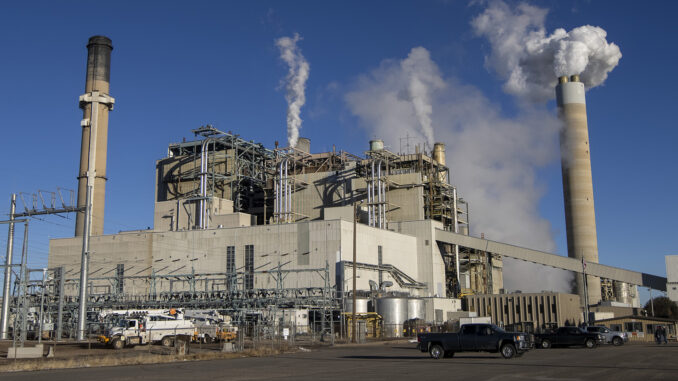
A new federal report disputes the claim that the United States will reach net-zero carbon emissions from power generation anytime soon.
While the share of energy that comes from wind and solar will increase, the projections say fossil fuels will remain king for the foreseeable future.
Future Energy Mix
The U.S. Energy Information Administration (EIA) produces an annual outlook that explores long-term energy trends in the United States. The report examines the country’s future energy mix and trends in energy demand, and projects greenhouse gas.
While President Joe Biden has stated that the nation will eliminate all fossil fuels within a decade, the EIA’s projections don’t support that goal.
According to the EIA’s latest report, by 2050, consumption of coal, natural gas and oil will still make up the majority of where Americans get their energy from. In 2022, 79% of our energy came from fossil fuels, and according to the EIA that will fall to 65% by 2050.
This year’s report factors in impacts of the so-called Inflation Reduction Act, which provides billions in subsidies to the renewable energy industry. As a result, wind, solar and battery storage will increase from 13% in 2022 to 29% in 2050.
The amount of energy from nuclear power will decline from 8% to 6% over the same period.
As a result of electrification of transportation, appliances, industry and home heating, electricity demand by 2050 will grow 27%.
Silly To Think
Kevin Kilty, a retired University of Wyoming adjunct professor of engineering, told Cowboy State Daily that the EIA is a good source of information.
“They generally are about as truthful as they can possibly be about things, but they operate under some political constraints like everybody else,” Kilty said.
There are other energy outlook reports by the United Nations and British Petroleum. One thing they all share in common, Kilty said, is they agree there’s no realistic scenario where fossil fuels are eliminated in the time frames they consider, which is 20 or 30 years.
“That’s just silly to even think about. Fossil fuels are going to be providing two thirds in almost all scenarios that these people can consider,” Kilty said.
Fossil fuels have properties that renewables, barring some unforeseen spectacular breakthrough, just can’t replace, Kilty said.
Storage
One of the points to notice in the EIA report, Kilty said, is where battery storage will be over the next few decades.
Electricity is consumed virtually at the moment of demand, meaning it has to be produced at the moment it’s used. The problem with wind and solar is that there’s no way to predict with any precision when it’s going to be available or not.
To smooth out its intermittency, energy storage will need to be used, which is very expensive, Kilty explained, and under all scenarios on the report storage never catches up to production.
To compensate for the lack of storage, the grid will have to be built out many times larger.
In the West, there’s very little storage. So, Kilty said, by the time coal- and natural gas-fired capacity are reduced, the West will need to import larger amounts of energy from other parts of the country.
Fairly Accurate
Thomas Pyle, president of the American Energy Alliance, told Cowboy State Daily the EIA has a track record of being fairly accurate in its projections of energy quantities. Where they fall shorts is in price forecasts, particularly natural gas.
Pyle said the projected penetration of renewables in the outlook report is likely on the high side, and the amount of fossil fuels projected is likely on the low side.
The projections also don’t account for the cost of having to back up intermittent resources from wind and solar. The more they are added to the grid, the more electricity prices rise.
While it’s often reported that wind and solar are cheaper than fossil fuels, these estimations rely on levelized cost of energy (LCOE), which is an estimate of the revenue required to build and operate a generator over a specified cost recovery period. It doesn’t include the costs associated with removing an existing source and adding an intermittent source to the grid.
Making direct comparisons across technologies using LCOE, according to the EIA, is “problematic and misleading.”
Yet most journalists and many studies use LCOE for these comparisons.
In a March 20 article on the EIA energy outlook report, the Casper Star Tribune cited a study from January that found Gillette’s Dry Fork Station power plant to be the only coal-fired power plant in the United States that’s cheaper to operate than replacing with renewables. The study relies entirely on LCOE.
Real World Outcomes
Energy and environmental policy expert Steve Goreham compared the electricity prices in leading wind states for an article he published earlier this month in WorldNetDaily, an independent online news source.
The states in the analysis are Texas, Iowa, Oklahoma, Kansas, Illinois, Colorado, North Dakota, California, New Mexico, Minnesota, Nebraska and Washington. Of those, only New Mexico, Oklahoma and North Dakota had electricity price increases lower than the national average of 27.3%. Texas was the only state to see a decrease.
All other leading wind states saw increases higher than the national average.
Pyle said it’s curious that wind and solar proponents claim the industries produce the cheapest electricity but also insist on continuing subsidies.
“I always find it frustrating that the proponents of renewables talk about how cheap it is all the time,” Pyle said. “But they also clamor for guaranteed market share production tax credits to be made permanent things.”
Emissions
Pyle said the demand increases as a result of electrification coupled with the growing reliance on intermittent solar and wind will also increase the grid reliability problems plaguing most areas of the country.
“It’s like a double whammy because they’re trying to force all this electrification, which is increasing the burden of electricity generation,” Pyle said.
The EIA outlook predicts that there will be a reduction of energy-related carbon dioxide emissions of 33% by 2030, which includes a 24% reduction that’s been achieved already. With the provisions of the Inflation Reduction Act, that includes trillions in spending, we will gain a total of 9% reduction in emissions.
“It’s not a lot of bang for your buck,” Pyle said.



